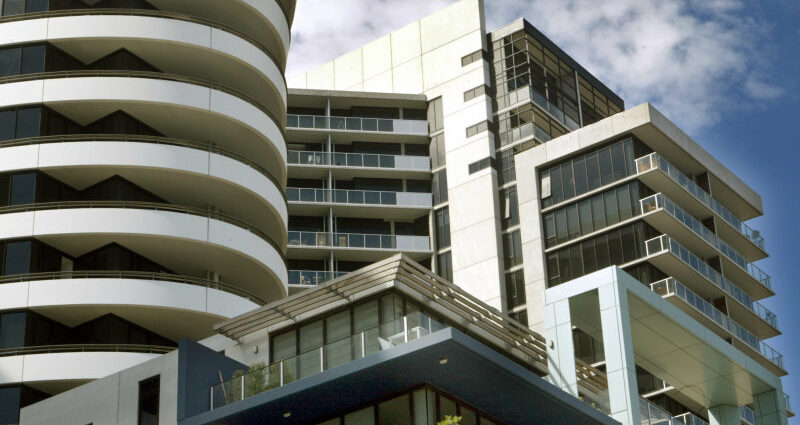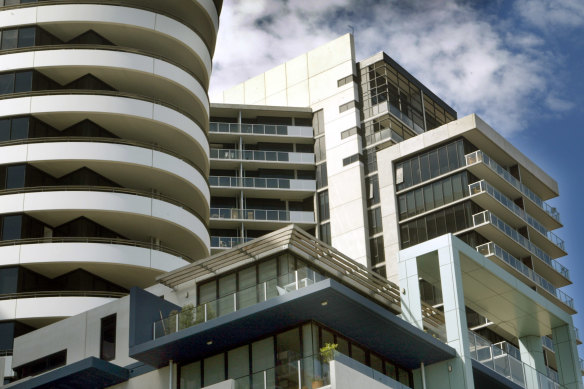Save articles for later
Add articles to your saved list and come back to them any time.
Many working families have been priced out of Melbourne’s inner- and middle-suburb rental markets under Victoria’s housing affordability policy, according to new research, as the state is urged to redefine “affordable”.
Commentators from across the sector, from developers to community housing providers, are calling for a revamp of current planning rules under which developers voluntarily agree to build so-called affordable housing into their projects.
Apartments in Melbourne’s DocklandsCredit: Simon Schluter
Community Housing Industry Association chief executive Jess Pomeroy said: “Any new initiatives to deliver affordable housing (rather than social housing) should be targeted to the people we know are missing out: low-wage and insecure workers.
“It’s the cleaners and baristas, childcare and aged care workers that can no longer afford the rent.”
Having framed the upcoming planning and housing reforms – due this month – as one of the most significant in the state’s history, Premier Daniel Andrews has repeatedly promised more quality affordable housing in existing suburbs, closer to places of work, social services and established infrastructure.
As part of the package, the government is looking to strip local councillors of some planning powers and remove objector rights in return for developers agreeing to include affordable housing in their projects.
But Labor is yet to clarify what its housing package will deem as “affordable”.
In 2018, the government amended the Planning and Environment Act to specify who is eligible for affordable housing when developers enter voluntary agreements to provide a proportion of such homes in new projects in return for concessions such as extra building height.
The act defines “affordable housing” as being “appropriate” for the needs of very low, low and moderate-income households. Regulations for eligibility set the maximum annual income for a family with children at $150,030.
Under a separate government benchmark, to qualify as “affordable”, the rent for a home must be set at 10 per cent below the area’s median market rate and absorb no more than 30 per cent of a household’s median income.
But detailed analysis for The Age by property experts CoreLogic shows that a single adult with an income of $59,540 – the mid-point of the government’s “moderate” income band – would currently have to pay more than 30 per cent of their income in rent for an “affordable” home across Melbourne’s 31 municipalities.
In many of those municipalities – including Bayside, Boroondara, Darebin, Glen Eira, Manningham, Port Phillip, Stonnington and Yarra – at least half of disposable income would be needed for rental costs, even when discounted by 10 per cent.
That suggests massive government subsidies or trade-offs for extra height or density would be needed to make housing affordable for lower-income households.
For families with children on a “moderate” income of $125,031, the situation was less dire, with housing costs exceeding 30 per cent in seven out of 31 municipalities. But for low-income households, rental costs were prohibitively expensive across most of Melbourne.
Experts have questioned the effectiveness of developer incentives to boost the supply of affordable homes given soaring building costs, rising interest rates and land values.
CoreLogic head of research Eliza Owen said it was increasingly difficult for the private sector to include affordable homes in their housing projects.
“Because of rising land values, high-interest rates, tight labour markets and increased material costs, the delivery of affordable housing can become less and less feasible, so you really do need government investment to support a counter-cyclical development of housing,” she said.
Pomeroy said merely asking the private sector to build more affordable housing will not work, especially for people on lower incomes.
“The biggest supply gap we have is in social housing,” she said. “Direct government investment in social housing is what made housing affordable in the post-war era, and it’s direct investment in not-for-profit housing that we should turn to now.”
Developers say simply imploring their industry to build more will not work in the current economic climate, where many apartment projects are not feasible even without a proportion of affordable homes.
“We’ve never seen a market like this or conditions like this with global supply chain problems, costs going up, values going down, interest rates going up, and everything is hitting the market at the same time,” said Mary Poulakos, senior development manager at Citta Property Group.
“Projects are not stacking up at full market value,” she said. “How the hell do you get affordability to work in that context?”
The state government did not directly answer questions about whether its upcoming housing package would include a new benchmark for affordability.
Last week, real estate research group PropTrack released its Housing Affordability Index, which showed that affordability across Australia is at its lowest level in decades, especially in NSW, Tasmania and Victoria.
It found that Victorian housing affordability had worsened markedly over the past 12-18 months.
”The sharp increase in mortgage rates since early 2022 means a household earning a median income can now afford fewer than one in 10 homes if they were to spend 25 per cent of their income on mortgage repayments,” the report said.
The Morning Edition newsletter is our guide to the day’s most important and interesting stories, analysis and insights. Sign up here.
Most Viewed in National
From our partners
Source: Read Full Article
-
Woman who thought heavy period due to Covid jab diagnosed with cancer
-
CO tech worker fired after posting TikToks about her salary
-
William appeared emotional as he kissed King Charles's cheek
-
Sex therapist with 50 animals loses bid to stop landlords evicting her
-
Teen dies on school trip after constant vomiting is put down to homesickness


